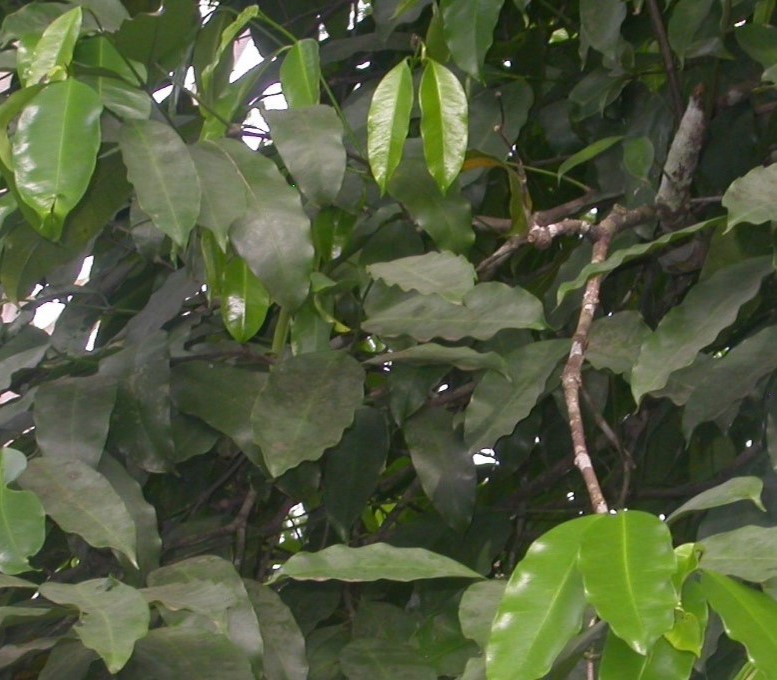Picralima nitida

|
|
Picralima nitida Common Names: Akuamma, Pile plant, Picralima,
Bitterstick, False cinchona Scientific
Classification Kingdom: Plantae Clade: Tracheophytes Clade: Angiosperms Clade: Eudicots Asterids Order: Gentianales Family: Apocynaceae Genus: Picralima Species: P. nitida Synonyms: Tabernaemontana nitida Stapf, Picralima klaineana Pierre, Picralima macrocarpa A.Chev. Morphological Description Picralima nitida is a deciduous shrub or tree, typically 9–22 meters tall,
with a trunk diameter up to 60 cm. Its key characteristics include: · Bark: Pale yellow to grayish, hard, elastic, exuding bitter white
latex when cut (Burkill, 1985). · Leaves: Simple, opposite, elliptic to oblong (10–25 cm × 4–10 cm),
glossy green above, paler beneath, with entire margins. · Flowers: White to yellow, fragrant, 2–3 cm long, in terminal cymes; 5
petals, tubular; flowering during rainy season (July–October) (Kew Science,
n.d.). · Fruit: Oblong capsules (5–10 cm), green when unripe, yellow-orange
when mature, containing brown, hard seeds with a pulpy white aril (Fern, 2024). Distribution and Habitat Picralima nitida is widely distributed across tropical Africa: · Geographic Range: West and Central Africa, from Ivory Coast
to Uganda, including Nigeria (e.g., Cross River, Lagos), Ghana, Cameroon, and
Democratic Republic of Congo; also in Madagascar (Kew Science, n.d.; Burkill,
1985). · Habitat: Thrives in humid lowland rainforests, secondary forests, and
forest edges; prefers moist, well-drained loamy soils (pH 5.0–7.0) with
1,500–3,000 mm annual rainfall; grows at elevations up to 1,200 m (Fern, 2024). · Ecological Role: Understory species in forests; supports
pollinators (bees); seeds dispersed by birds and mammals; can dominate
secondary growth (Burkill, 1985). Ethnopharmacology Picralima nitida, known as akuamma, is a cornerstone of West African traditional
medicine, valued for its antimalarial, analgesic, and antidiabetic properties.
Its pharmacological potential is driven by over 40 bioactive compounds, with
extensive studies validating traditional uses. Traditional Uses In African
ethnomedicine, particularly among Yoruba, Igbo, and Akan communities, Picralima nitida is used for: · Malaria and Fever: Seed and bark decoctions treat malaria and
fevers in Nigeria and Ghana. · Pain and Inflammation: Leaf and seed pastes relieve arthritis,
headaches, and wounds in Cameroon (Neuwinger, 2000). · Infections: Root and seed extracts manage dysentery, gonorrhea, and skin
infections in Ivory Coast (Erharuyi et al., 2014). · Diabetes: Leaf infusions lower blood glucose in Nigeria and Benin · Gastrointestinal Disorders: Bark decoctions treat diarrhea, ulcers,
and intestinal worms in Ghana (Dibong et al., 2011). · Reproductive Health: Seeds address erectile dysfunction and
female infertility in Nigeria (Erharuyi et al., 2014). Pharmacological Studies Pharmacological studies
have validated numerous traditional uses of Picralima nitida, focusing on its seeds, bark, and leaves: · Antimalarial Activity: Methanolic seed extracts inhibited
Plasmodium falciparum W2 strain (IC50: 10 µg/mL) and reduced Plasmodium berghei parasitemia in mice
by 60% at 300 mg/kg, with akuammine as a key compound, supporting Yoruba use
for malaria (Bickii et al., 2004). · Analgesic and Anti-inflammatory Activity: Methanolic fruit extracts (300 mg/kg)
inhibited carrageenan-induced paw edema in rats by 72.2% (IC50: 102 mg/kg) and
suppressed PGE2 production via NF-κB and MAPK pathways, validating use for pain
in Ghana (Olajide et al., 2014). · Antidiabetic Activity: is use for diabetes · Antimicrobial Activity: Methanolic seed extracts inhibited
*Staphylococcus aureus* (MIC: 0.5 mg/mL) and *Escherichia coli* (MIC: 1 mg/mL),
with akuammidine disrupting bacterial membranes, validating use for infections
in Ivory Coast (Afagnigni et al., 2020). · Antiulcer Activity: Methanolic bark extracts (200 mg/kg)
reduced Shigella-induced diarrhea in rats by 50%, protecting gastric mucosa via
tannin-mediated astringency, supporting Akan use for gastrointestinal issues
(Kouitcheu et al., 2013). ⚠ Safety Considerations: Picralima nitida is generally safe at
therapeutic doses, but some risks are noted. Side Effects: High doses may cause
dizziness, nausea, or sedation due to alkaloids like akuammine (Olufunsho et
al., 2019) Additional Information · Traditional Herbal Formulations: Seeds are a key ingredient in "MAMA
powder," an NAFDAC-approved antimalarial remedy from Nigeria. · Cultural Significance: In Yoruba culture, seeds are used as
talismans for spiritual protection; revered as a "bitter healer" in
Akan folklore (Neuwinger, 2000). · Pharmaceutical Potential: Akuammine and akuammidine are under
investigation for analgesic and antimalarial drug development (Erharuyi et al.,
2014). · Ecological Role: Understory species in rainforests;
supports pollinators; seeds dispersed by birds; can dominate secondary forests
(Burkill, 1985). · Other Uses: Crushed seeds used as fish poison; roots in arrow poisons in
Central Africa (Fern, 2024). References
External Links More Pictures |
|
| Compounds of Picralima nitida | |
| References |